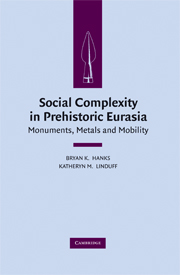Book contents
- Frontmatter
- Contents
- Contributors
- Foreword: From Myth to Method: Advances in the Archaeology of the Eurasian Steppe
- CHAPTER 1 Introduction: Reconsidering Steppe Social Complexity within World Prehistory
- PART ONE FRAMING COMPLEXITY
- PART TWO MINING, METALLURGY, AND TRADE
- PART THREE FRONTIERS AND BORDER DYNAMICS
- CHAPTER 13 Introduction
- CHAPTER 14 Violence on the Frontiers? Sources of Power and Socio-Political Change at the Easternmost Parts of the Eurasian Steppe during the Late Second and Early First Millennia BCE
- CHAPTER 15 First-Millennium BCE Beifang Artifacts as Historical Documents
- CHAPTER 16 Blurring the Boundaries: Foragers and Pastoralists in the Volga-Urals Region
- PART FOUR SOCIAL POWER, MONUMENTALITY, AND MOBILITY
- Index
CHAPTER 15 - First-Millennium BCE Beifang Artifacts as Historical Documents
from PART THREE - FRONTIERS AND BORDER DYNAMICS
Published online by Cambridge University Press: 26 January 2010
- Frontmatter
- Contents
- Contributors
- Foreword: From Myth to Method: Advances in the Archaeology of the Eurasian Steppe
- CHAPTER 1 Introduction: Reconsidering Steppe Social Complexity within World Prehistory
- PART ONE FRAMING COMPLEXITY
- PART TWO MINING, METALLURGY, AND TRADE
- PART THREE FRONTIERS AND BORDER DYNAMICS
- CHAPTER 13 Introduction
- CHAPTER 14 Violence on the Frontiers? Sources of Power and Socio-Political Change at the Easternmost Parts of the Eurasian Steppe during the Late Second and Early First Millennia BCE
- CHAPTER 15 First-Millennium BCE Beifang Artifacts as Historical Documents
- CHAPTER 16 Blurring the Boundaries: Foragers and Pastoralists in the Volga-Urals Region
- PART FOUR SOCIAL POWER, MONUMENTALITY, AND MOBILITY
- Index
Summary
Ancient chinese texts often mention pastoral peoples living in the beifang, but the textual descriptions range from misleading to inaccurate, portraying them as wily, needy, ruthless people without honor who constantly harassed their Chinese neighbors. Modern scholars tend to base their opinions on the ancient Chinese records, viewing the beifang as a reservoir of “barbarian” activities that have periodically contaminated Eastern Zhou, Qin, and Han Chinese culture. As a result, the beifang “folk” have been consistently given poor scholarly press over the years without any recognition of their cultural achievements. This lacuna is being blamed, in part, on the supposed lack of written records provided by the beifang groups themselves.
In lieu of written records from the beifang, I intend to demonstrate that excavated beifang artifacts can serve as encoded historical records, as has been suggested for various other “prehistoric” cultures (Hodder 1986; Pruecel 2006), revealing details of daily life, regional characteristics, metallurgical techniques, and exotic cultural contacts about which we have much to learn. The artifacts belong to archaeological cultures that are markedly specific to geographic locations. Only very recently has any part of this region been studied systematically with the goal of understanding the socio-political background of the peoples who appear to be represented by these artifacts (Linduff 1997 a; Linduff et al. 2002–2004; Indrisano and Linduff forthcoming). If we can decode the information, long hidden from our understanding, that such artifacts provide, we will see that the view is significantly different from what we have traditionally associated with the beifang.
- Type
- Chapter
- Information
- Social Complexity in Prehistoric EurasiaMonuments, Metals and Mobility, pp. 272 - 295Publisher: Cambridge University PressPrint publication year: 2009
- 2
- Cited by

